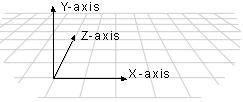
There are two varieties of Cartesian coordinate systems in 3-D graphics: left-handed and right-handed. In both coordinate systems, the positive x-axis points to the right and the positive y-axis points up. You can remember which direction the positive z-axis points by pointing the fingers of either your left or right hand in the positive x-direction and curling them into the positive y-direction. The direction your thumb points, either toward or away from you, is the direction the positive z-axis points for that coordinate system.
Direct3D uses a left-handed coordinate system. This means the positive z-axis points away from the viewer, as shown in the following illustration:

In a left-handed coordinate system, rotations occur clockwise around any axis that is pointed at the viewer.
If you need to work in a right-handed coordinate system ¾ for example, if you are porting an application that relies on right-handedness ¾ you can do so by making two simple changes to the data passed to Direct3D.
·Flip the order of triangle vertices so that the system traverses them clockwise from the front. In other words, if the vertices are v0, v1, v2, pass them to Direct3D as v0, v2, v1.
·Scale the projection matrix by -1 in the z-direction. To do this, flip the signs of the _13, _23, _33, and _43 members of the D3DMATRIX structure.